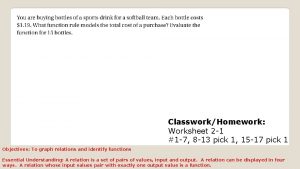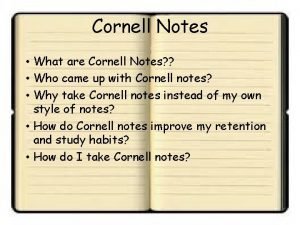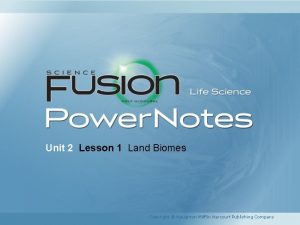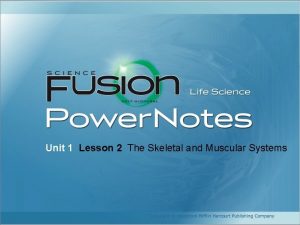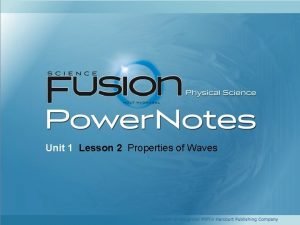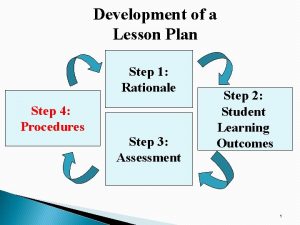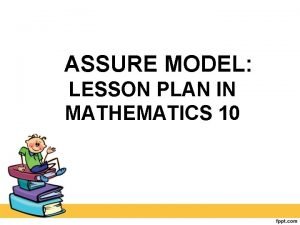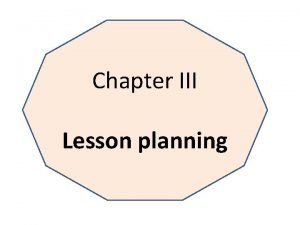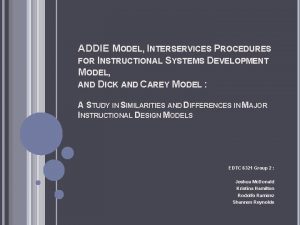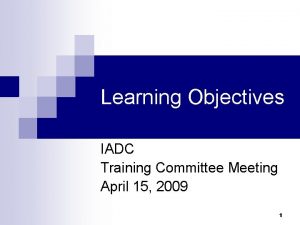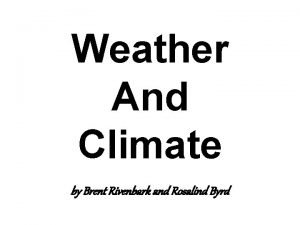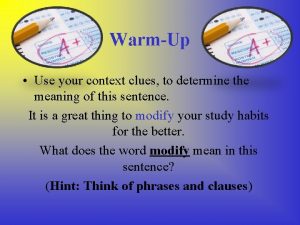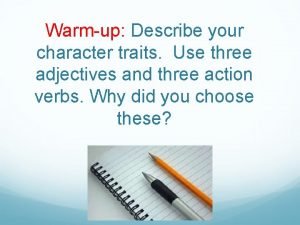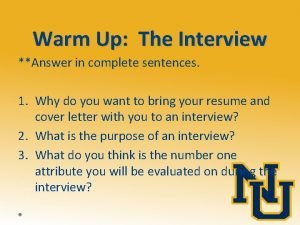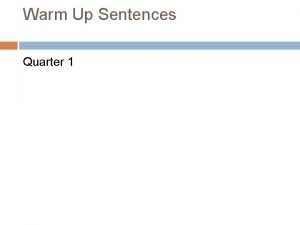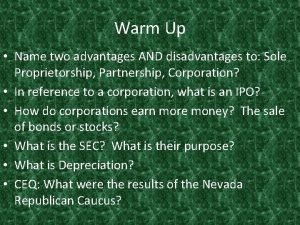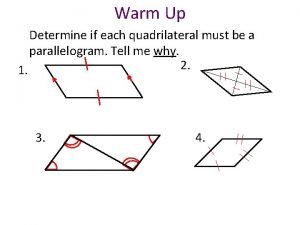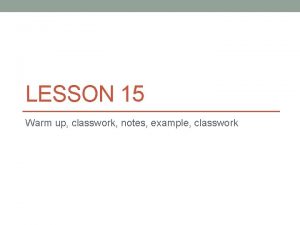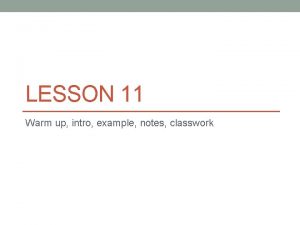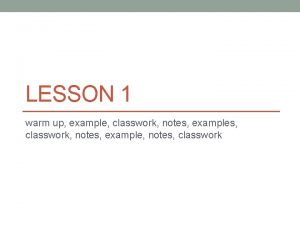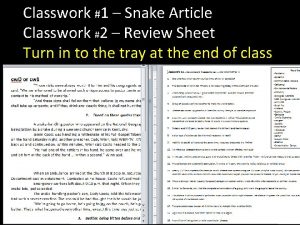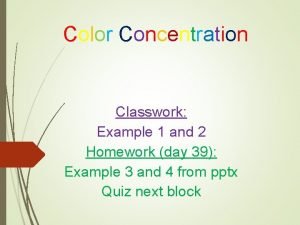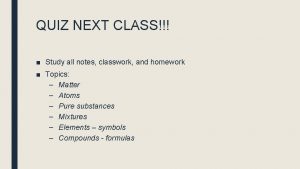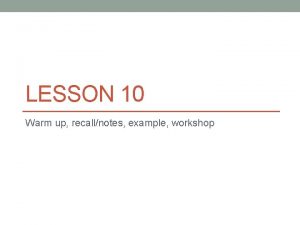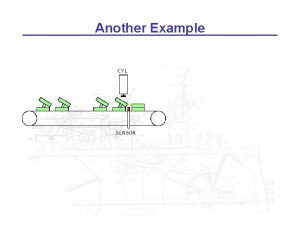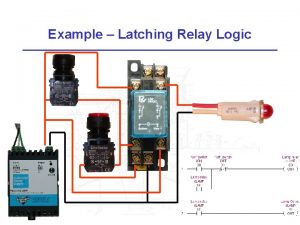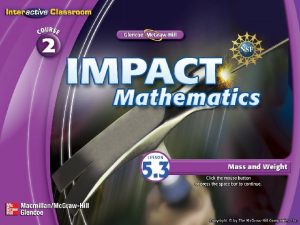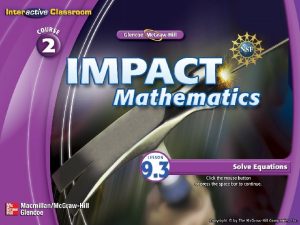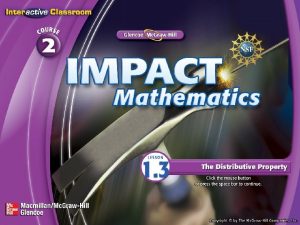LESSON 1 Warm up example notes classwork Warm

































































- Slides: 65

LESSON 1 Warm up, example, notes, classwork

Warm Up Take out the function summary chart from yesterday. Talk with your neighbor to fill in any information you missed: • Function type • Overall shape • x- and y-intercepts • Vertex • Symmetry • End behavior • Domain and range (restrictions)



Discussion • When presented with a graph, what is the most important key feature that helps you recognize the type of function it represents? • Which graphs have a minimum or maximum value? • Which have domain restrictions? What are those restrictions? • Which have restrictions on their range? • Which have lines of symmetry? • Which of the parent functions are transformations of other parent functions? • How are you able to recognize the function if the graph is a transformation of the parent function?

Example • Units? Define the relationship. Story from graph. Function type? 4 points enough for equations? What do you notice about the pieces?

Notes Graphs can be used to represent a function/model a context. Advantages: overall picture/story Disadvantages: estimated values Advantage of writing an equation to model the situation: • Precise values, predict for values beyond the graph To write equation: 1) Identify variables and general relationship 2) Recognize the parent function and note key features 3) Notice transformations on the parent function

Classwork Must Do May Do • Function summary chart • Khan Academy • Classwork 1 #1 - 6 • Exponents review • Linear equation practice • Slope practice • Vocabulary in notebook • Flashcards

LESSON 2 Warm up, notes, example, classwork

Warm Up When tables are used to model functions, we typically have just a few sample values of the function and therefore have to do some detective work to figure out what the function might be. Look at these three tables. Can you determine what type of function each represents?

Warm Up Can you justify your choices with graphs?

Notes You can determine some functions from their tables: Linear – constant rate of change in the first differences Quadratic – pattern in the first differences; second differences are equal; symmetrical (increase then decrease or other way around) Exponential – multiplying by a constant rate Absolute value – symmetrical but with constant rate Square root, cubic, and cube root are really difficult to tell from a table. Cubic – constant 3 rd differences…

Example Noam and Athena had an argument about whether it would take longer to get from NYC to Boston and back by car or by train. To settle their differences, they made separate, nonstop round trips from NYC to Boston. On the trip, at the end of each hour, both recorded the number of miles they had traveled from their starting points in NYC. The tables below show their travel times, in hours, and the distances from their starting points, in miles. The first table shows Noam’s travel time and distance from the starting point, and the second represents Athena’s. Use both data sets to justify your answers to the questions below.

Example Who do you think is driving and who on the train? How far apart are NYC and Boston? How long did it take each person to make the round trip? Which was faster? What if you compare rates of change? Noam says both are quadratic. Do you agree?

Classwork Must Do • Classwork 2 #1 - 2 May Do • Khan Academy • Exponents review • Linear equation practice • Slope practice • Vocabulary in notebook • Flashcards • Classwork 1 • PARCC practice packet

LESSON 3 Warm up, notes, examples, classwork

Placement Test Prep A spinner for a game is circular shaped and has 5 equal sections. Each section is labeled with the numbers 1 -5. Draw it. a. What is the sample space of the spinner? b. What is the probability of spinning a 2? 3? 5? 0? c. What is the experimental probability of landing on 3 when the spinner is spun 700 times and the spinner lands on 3 240 times? d. How does the answer for c relate to theoretical probability in b? e. Would you consider this spinner to be “fair”?

Warm Up Take a minute and brainstorm situations we have looked at that are generally represented by linear, exponential, and quadratic functions. Linear Exponential Quadratic

Notes •

Example 1 •

Example 2 •

Example 3 •

Classwork Must Do May Do • Classwork 3 #1 – 4 • Khan Academy • Summary question • Exponents review • Linear equation practice • Slope practice • Vocabulary in notebook • Flashcards • PARCC practice packet

LESSON 4 Warm up, example, classwork

Placement Test Prep You roll two (6 -sided) number cubes, a red one and a white one. Find each probability: a. P(5, 2) b. P(5, odd #) c. P(3, 3) d. P(even #, odd #) e. P(4, 4) f. P(less than 5, 6)

Warm Up Look at the card you were given (equation or a graph). --If you have an equation, try to picture what the graph will look like. --If you have a graph, try to think about what the equation should be. Go find your match!

Modeling Lessons 1 -3 (and the matching warm up) focused on the first two or three steps of the this cycle: Given a problem, formulate the function/model with an equation, graph, and/or table. Lessons 4 -9 focus on the entire cycle

Example The relationship between the length of one of the legs, in feet, of an animal and its walking speed, in feet per second, can be modeled by the graph below. Note: This function applies to walking not running speed. Obviously, a cheetah has shorter legs than a giraffe but can run much faster. However, in a walking race, the giraffe has the advantage. First – estimate an answer using the graph to get a ballpark answer!

Example • Now, what are the units involved? What type of function does this graph represent?

Example •

Example •

Classwork Must Do • Classwork 4 #1 – 3 May Do • Khan Academy • Exponents review • Linear equation practice • Slope practice • Vocabulary in notebook • Flashcards • PARCC practice packet

LESSON 5 Warm up, review, examples, classwork

Placement Test Prep Find the probability of each event. Use a standard deck of 52 playing cards P(5, 2) a) P (heart) b) P (heart, heart) [without replacement] c) P (heart, heart) [w/ replacement] d) P (heart, heart) [w/o replacement]

Warm Up Open your notebook and review your notes and examples from module 3 lessons 1, 2, and 3 (about arithmetic and geometric sequences).

Recall •

Recall •

Example 1 •

Example 2 A soccer coach is getting her students ready for the season by introducing them to High Intensity Interval Training (HIIT). She presents the table below with a list of exercises for a HIIT training circuit and the length of time that must be spent on each exercise before the athlete gets a short time to rest. The rest times increase as students complete more exercises in the circuit. Study the chart and answer the questions below. Quantities and variables? What type(s)?

Example 2, continued Exercise time: Rest time: Type? Equation? How long for 10 th exercise? How much rest?

Example 2, continued • Exercise # Ex. Time Rest Time Total Time

Classwork Must Do May Do • Classwork 5 #1 – 3 • Khan Academy • Summary question • Exponents review • Linear equation practice • Slope practice • Vocabulary in notebook • Flashcards • PARCC practice packet

LESSON 6 Warm up, example, classwork

Placement Test Prep For a certain carnival game, you can win a prize by throwing two darts at the square board pictured below. Find the following probabilities: a. P (even number the first dart) = b. P (even number, odd number) = c. P (even, even) = d. P (2, 3) = e. P (sum of 4) = f. P (2, 2) =

Warm Up For your assigned table: identify the type of function, write an equation, and make a graph.

Example •

Example Although the graph looks linear, the first differences are 101, 103, 105, 107. . Indicating a constant second difference and quadratic pattern. SCALES ON GRAPHS CAN MAKE THINGS DECEIVING

Example Use points to find equation: (0, 1000) (1, 899) (2, 796) Use equation to find when population gone. How else could you have answered question?

Classwork Must Do • Classwork 6 #1 – 3 May Do • Khan Academy • Exponents review • Linear equation practice • Slope practice • Vocabulary in notebook • Flashcards • PARCC practice packet

LESSON 7 Warm up/review, examples, classwork

Warm Up Go back through your MODULE 2 notes to review the content about data collection and statistics.

Example What is this data table telling us about? 1) What function type appears to best suit this data? 2) Can we model this data precisely using methods from lessons 1 -6? 3) What questions might we want to ask?

Review •

Example 2 •

Example 1, revisited • Enter this into your calculator. • Find the regression equation that best fits the data. --How exact do our numbers need to be? --Why is all data in quadrant 1 and no zeros? --What is the best age to run a marathon? --Based on model, what time would a 50 -year old get?

Classwork Must Do May Do • Classwork 7 #1 – 2 • Exponents review • Summary question • Linear equation practice • Slope practice • Vocabulary in notebook • Flashcards • PARCC practice packet

LESSON 8 Warm up/review, examples, classwork

Warm Up Go back through your MODULE 4 notes to review the material on business: revenue, costs, and profit. Also review the notes from lesson 5 of this module about compound interest.

Example 1 •

Example 2 •

Classwork Must Do May Do • Classwork 8 #1 – 3 • Exponents review • Linear equation practice • Slope practice • Vocabulary in notebook • Flashcards • PARCC practice packet • Note sheet • Folder

LESSON 9 Warm up, classwork

Warm Up What does it mean to attend to precision when modeling in mathematics?

Classwork Must Do Create a poster for your assigned problem. • Title • Answer all parts • Work shown • Graphs/tables/equations included as dictated • Should show the modeling cycle! May Do • Khan Academy • Exponents review • Linear equation practice • Slope practice • Vocabulary in notebook • Flashcards • PARCC practice packet • Note sheet • Folder

Test Content 1) Comparing two options for payment to determine which is best (module 3) -- Write equations, sketch graph and determine when each option better 2) Choose best type of function from table (module 4) -- Choose type and explain why; Write equation; Analyze 3) Cost/Revenue/Profit problem 4) Using regressions to choose best model and then predict (modules 2, 5) 5) Analyzing quadratic (module 4) -- Use vertex to write equation -- Rate of change comparison 6) Compare quadratic and absolute value functions (module 5) -- Tables; Graphs; Equations 7) Flatland questions
 Http://www.explorelearning.com
Http://www.explorelearning.com Classwork/homework linear functions answer key
Classwork/homework linear functions answer key Welcome to google classroom
Welcome to google classroom Name the geometric term modeled by each object
Name the geometric term modeled by each object Is classwork one word
Is classwork one word Cube wisc
Cube wisc Free example birp notes
Free example birp notes Descriptive notes example
Descriptive notes example Cornell notes setup
Cornell notes setup Fph cpd
Fph cpd Concept notes example
Concept notes example Concept notes example
Concept notes example Science cornell notes
Science cornell notes Lesson outline lesson 3 describing circuits answers
Lesson outline lesson 3 describing circuits answers Lesson outline lesson 3 mountain building answers
Lesson outline lesson 3 mountain building answers Lesson outline lesson 2 aquatic ecosystems answer key
Lesson outline lesson 2 aquatic ecosystems answer key Microteaching lesson plans
Microteaching lesson plans Ihi leadership alliance
Ihi leadership alliance The beggar learning objectives
The beggar learning objectives Chapter 1 lesson 1 your total health answer key
Chapter 1 lesson 1 your total health answer key Weather forecasts lesson 3 outline answers
Weather forecasts lesson 3 outline answers Sat vocabulary lesson 4
Sat vocabulary lesson 4 Lesson 3 physical changes answer key
Lesson 3 physical changes answer key The science duo physical and chemical changes
The science duo physical and chemical changes Lesson outline lesson 1 climates of earth answers key
Lesson outline lesson 1 climates of earth answers key Glottodidactics
Glottodidactics Lesson 1 understanding science answer key
Lesson 1 understanding science answer key Fingerprint galton details
Fingerprint galton details Biome
Biome Lesson 4 gravity and motion lesson review
Lesson 4 gravity and motion lesson review Lesson outline lesson 2 the muscular system answer key
Lesson outline lesson 2 the muscular system answer key Wave properties lesson 2
Wave properties lesson 2 Today's lesson or today lesson
Today's lesson or today lesson 1 important lesson that is worth sharing about this lesson
1 important lesson that is worth sharing about this lesson Example of repitition
Example of repitition Scrap heap magnet circuit diagram
Scrap heap magnet circuit diagram Lesson outline lesson 3 eclipses and tides answer key
Lesson outline lesson 3 eclipses and tides answer key Three stages of backward design
Three stages of backward design Lesson review example
Lesson review example Engage activate study
Engage activate study Example of a rationale for a lesson plan
Example of a rationale for a lesson plan Assure model lesson plan mathematics
Assure model lesson plan mathematics Ppp lesson plan
Ppp lesson plan Language experience approach example
Language experience approach example Lesson plan rationale example
Lesson plan rationale example Multicultural lesson plan example
Multicultural lesson plan example Sample lesson plan using assure model
Sample lesson plan using assure model Agreeing and disagreeing ppp lesson plan
Agreeing and disagreeing ppp lesson plan Mastery learning lesson plan examples
Mastery learning lesson plan examples Addie model example lesson plan
Addie model example lesson plan Brief lesson plan
Brief lesson plan Example of objectives in lesson plan
Example of objectives in lesson plan Cognitive objectives examples
Cognitive objectives examples Lesson review example
Lesson review example Stationary front symbol
Stationary front symbol Infiltration in water cycle
Infiltration in water cycle Warm up comic
Warm up comic Context clues worksheets
Context clues worksheets Context clues warm up
Context clues warm up Steal characterization examples
Steal characterization examples Warm up questions
Warm up questions Interview warm up
Interview warm up Warm sentence
Warm sentence Disadvantages of warm up
Disadvantages of warm up Pyramid warmup
Pyramid warmup State whether each shape is a quadrilateral
State whether each shape is a quadrilateral

